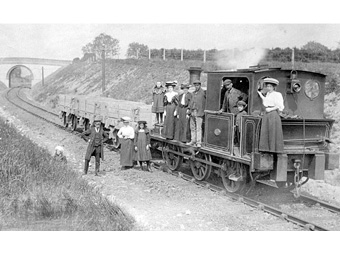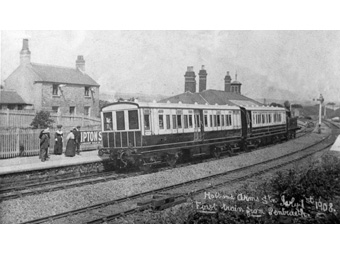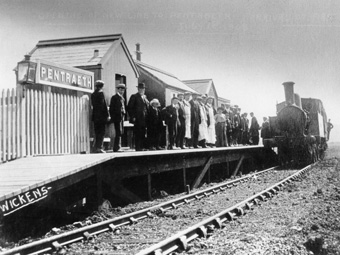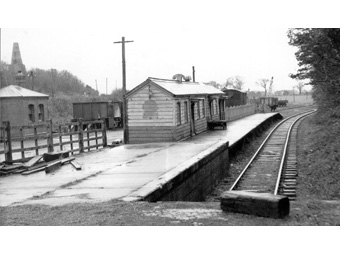

Rails to Red Wharf Bay
by David Mills
Contractor's engine near Holland Arms
As early as the 16th century coal mining was carried out in the Malltraeth marshes in central Anglesey. Coal would have been transported away at considerable expense by mules, packhorses and wagons. By the early 19th century a canal was proposed to reduce costs, but was later rejected in favour of a cheaper and simpler tramway, either to Malltraeth on the west coast or Traeth Coch (Red Wharf Bay) on the east coast. Malltraeth was later rejected due to strong on-shore westerly winds that would have made it difficult to sail the small ships into the prevailing winds. The more sheltered shores of Traeth Coch were favoured as it was also cheaper to transport from there to Ireland than from other North Wales ports. An Act of Parliament was finally granted in 1812 to build it, but it never materialised, despite the many later rumours of its one-time existence. It wasn't until 1899 that Parliamentary powers were obtained by the LNWR to build a six-mile single line branch line from Holland Arms to Red Wharf Bay, branching off the old Anglesey Central Railway that ran between Gaerwen and Amlwch. This development occurred long after coal mining had ceased in the area due to constant flooding. It did, however, run very close to the proposed early tramway route. The new line was built by J Strachan of Cardiff and was opened on July 1 1908 as far as Pentraeth and carried passenger and goods traffic. The line was extended to Red Wharf Bay and Benllech station and fully opened May 24 1909. An early type of twin coach push-pull train ran on the branch for some years, later to be incorporated into the LMS grouping in 1923. The stations were named Holland Arms, Ceint, Rhyd y Saint, Pentraeth, Llanbedrgoch and Red Wharf Bay and Benllech - the latter station being located typically Trains comprised of passenger and freight trains carrying coal, agricultural produce, building materials, farm feed, livestock etc. It could become very busy during summer weekends in the early years, with sometimes about 300 passengers, and the 4pm was sometimes met with as many as 50 horse traps and carts. The winter of 1922/3 saw a great herring shoal between Moelfre and Benllech. Five hundred tons were landed and moved in two weeks in 12 special trains destined for London, Liverpool, Manchester, Birmingham etc. Due to the rapid expansion of rural road transport in the 1920s, regular passenger services finally ceased on September 22 1930 and goods traffic on April 3 1950. The track was all removed by October 16 1953 and the remaining timber station building left to rot away over the next decade or so. If you go in search of it today there is little to remind us of its previous existence except for some earthworks and a few remaining bridges. Holland Arms station is the only survivor and has been wonderfully restored by the present owner, but one must appreciate it is now on private land. There was a tale of a not-too-bright farm boy who removed Ceint timber platform station hut by mistake thinking it was a new shed being delivered for his farm. There was also the one of an old woman who entered the train at Llanbedrgoch carrying poached rabbits. When the local policeman tried to arrest her, he was refused entry onto the train, as he had no money to buy a ticket. Those were the days! It has been said that a film of the railway was made. Does anyone know about it please? For more local news and stories, you can subscribe to our free Anglesey Newsletter here. It's as easy as 1-2-3!
|









